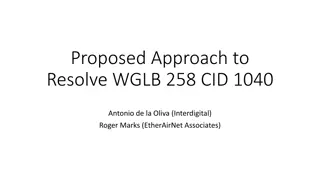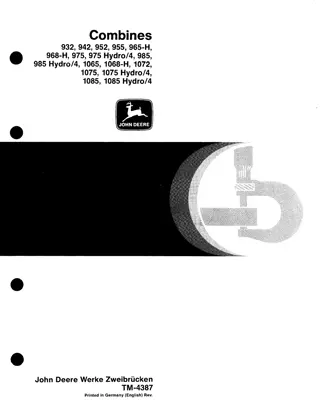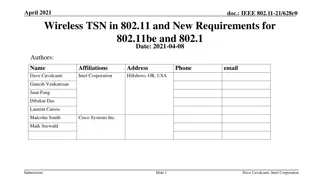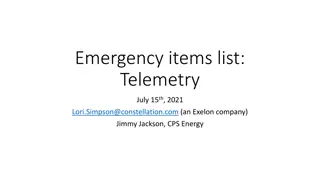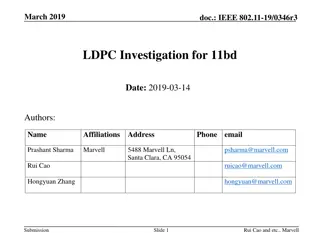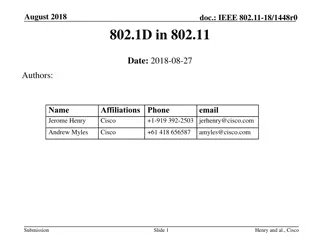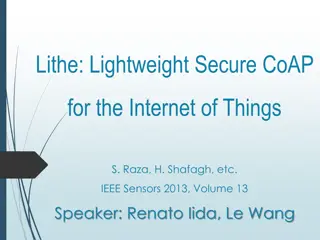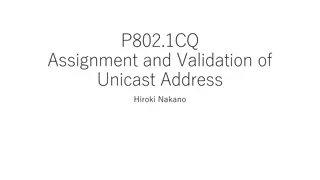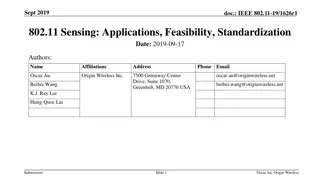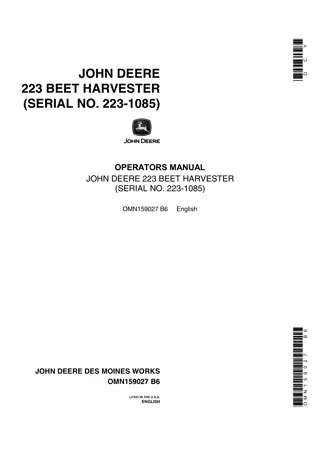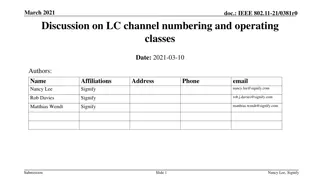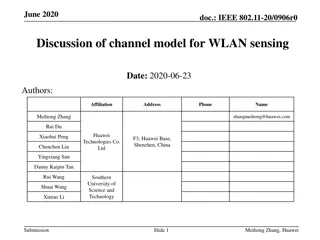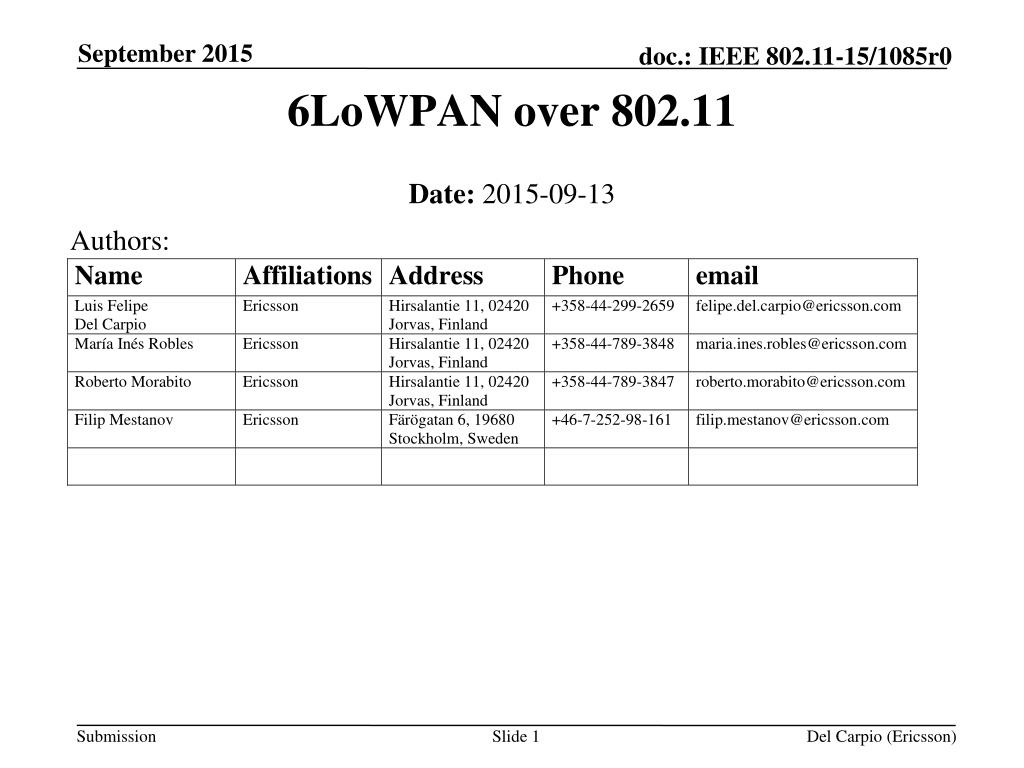
Enhancing IEEE 802.11 for IoT with 6LoWPAN Compression
"Explore the integration of 6LoWPAN compression protocol with IEEE 802.11 to optimize network performance for Internet of Things (IoT). Learn about the compatibility, motivation, and background of this innovative approach for efficient data transmission in wireless networks."
Uploaded on | 0 Views
Download Presentation

Please find below an Image/Link to download the presentation.
The content on the website is provided AS IS for your information and personal use only. It may not be sold, licensed, or shared on other websites without obtaining consent from the author. If you encounter any issues during the download, it is possible that the publisher has removed the file from their server.
You are allowed to download the files provided on this website for personal or commercial use, subject to the condition that they are used lawfully. All files are the property of their respective owners.
The content on the website is provided AS IS for your information and personal use only. It may not be sold, licensed, or shared on other websites without obtaining consent from the author.
E N D
Presentation Transcript
September 2015 doc.: IEEE 802.11-15/1085r0 6LoWPAN over 802.11 Date: 2015-09-13 Authors: Name Luis Felipe Del Carpio Mar a In s Robles Affiliations Address Ericsson Phone +358-44-299-2659 email felipe.del.carpio@ericsson.com Hirsalantie 11, 02420 Jorvas, Finland Hirsalantie 11, 02420 Jorvas, Finland Hirsalantie 11, 02420 Jorvas, Finland F r gatan 6, 19680 Stockholm, Sweden Ericsson +358-44-789-3848 maria.ines.robles@ericsson.com Roberto Morabito Ericsson +358-44-789-3847 roberto.morabito@ericsson.com Filip Mestanov Ericsson +46-7-252-98-161 filip.mestanov@ericsson.com Submission Slide 1 Del Carpio (Ericsson)
September 2015 doc.: IEEE 802.11-15/1085r0 Outline Outlook Background Motivation What is 6LoWPAN? LLC SNAP and EPD Compatibility Compatibility with Protocol Versions Compression Principles 6LOWPAN (RFC 6282) 6LoWPAN Dispatch Field 6LoWPAN Header 6Lo for 802.11 Evaluations Discussion Submission Slide 2 Del Carpio (Ericsson)
September 2015 doc.: IEEE 802.11-15/1085r0 Outlook WLAN is a widespread and popular wireless technology, thus it makes sense to improve 802.11 for IoT use cases WLAN + higher layer protocols will be enablers of IoT Higher layer protocols are designed for IoT at IETF IEEE defines PHY & MAC layers We invite the IEEE community to comment to the author on the feasibility to apply: IPv6 header compression in for 802.11 systems 6LoWPAN Protocol as a header compression protocol to be used with 802.11 Submission Slide 3 Del Carpio (Ericsson)
September 2015 doc.: IEEE 802.11-15/1085r0 Background IoT is a current topic in IEEE and IETF discussions IEEE 802.11ah is one WLAN solution for IoT Channel bandwidth is reduced to 2 MHz and OFDM symbol duration is 40 s (longer transmission durations) 6LoWPAN (IPv6 over Low-Power Wireless Personal Area Networks) was developed for 802.15.4 and currently is being adapted at IETF for different radio technologies E.g. BLUETOOTH(R) Low Energy , MS/TP Networks , DECT Ultra Low Energy, Near Field Communication, ITU-T G.9959 Networks Submission Slide 4 Del Carpio (Ericsson)
September 2015 doc.: IEEE 802.11-15/1085r0 Motivation IoT devices are expected to transmit short packets, thus reduction of overhead in all layers is welcomed 802.11ah has worked in reducing L2 overhead Payload size affects the transmission duration What about reduction of L3 (IPv6) overhead optimized for 802.11? Adaptation of 6LoWPAN compression for 802.11ah was proposed at IETF to improve performance of 802.11ah Reducing air-time of transmission is good for 802.11 The needed elements are present in 802.11, thus no modification in L1/L2 are required Submission Slide 5 Del Carpio (Ericsson)
September 2015 doc.: IEEE 802.11-15/1085r0 What is 6LoWPAN? 6LoWPAN is an IETF Protocol designed for Transmission of IPv6 Packets over IEEE 802.15.4 Networks (rfc4944 , rfc6282) 6LoWPAN allows compression of IPv6 header and other headers such as UDP IPv6 overhead reduction from 40bytes to e.g. 2/3 bytes The 6Lo Working Group in IETF (https://tools.ietf.org/wg/6lo/) adapts 6LoWPAN protocol to other link layers technologies E.g. 6LoWPAN for Bluetooth Low Energy is being finalized (https://tools.ietf.org/wg/6lo/draft-ietf-6lo-btle/) Submission Slide 6 Del Carpio (Ericsson)
September 2015 doc.: IEEE 802.11-15/1085r0 6LoWPAN allows IPv6 6LoWPAN is just an adaptation layer between 802.11 LLC and IPv6. Sensor STA AP Higher layers IPv6 IPv6 6LoWPAN 6LoWPAN internet 802.11 LLC 802.11 LLC Ethernet MAC 802.11 MAC 802.11 PHY 802.11 PHY 802.11 MAC header higher layers MAC header IPv6 header higher layers PHY LLC 6LoWPAN PHY LLC Fig 1. Example of a stack including 6LoWPAN Submission Slide 7 Del Carpio (Ericsson)
September 2015 doc.: IEEE 802.11-15/1085r0 LLC SNAP and EPD Compatibility All MSDU is a LLC PDU (Section 5.1.4 802.11) New Ethertype can be used to indicate 6LoWPAN compression protocol being fully backwards compatible Bytes: 1 2 3 3 2 variable DSAP 0xAA SSAP 0xAA CTL OUI: 00-00-00 Ethertype e.g. 6LoWPAN MSDU 0x03 =UI Fig 2. Format of LPD compatible with current 802.11 recommendations If the 6LoWPAN is discrimated by Ethertype, then it will be compatible with EPD as well. Submission Slide 8 Del Carpio (Ericsson)
September 2015 doc.: IEEE 802.11-15/1085r0 Compatibility with Protocol Versions (PV) 6LoWPAN can be used with both PV0 and PV1 PV0 is the current format for data frames for 802.11 PV1 is defined by the 802.11ah amendment as a format with less optional fields It is expected that PV0 will be used in early 802.11ah STAs and PV1 will be deployed particularly in sensor type STAs, therefore compatibility with both Protocol Versions is desired for 6LoWPAN Submission Slide 9 Del Carpio (Ericsson)
September 2015 doc.: IEEE 802.11-15/1085r0 Compression Principles 1/2 6LoWPAN compresses the header reducing redundancy Some information is deducted from underlying link layer This achieves an efficient transport of IPv6 headers and next headers In some cases, IPv6 addresses can be deduced from MAC addresses IP payload length can be deduced from L2/L1 length information Traffic Class and Flow Label values are set to zero Version field value is IPv6 Hop limit can be set to predefined values Submission Slide 10 Del Carpio (Ericsson)
September 2015 doc.: IEEE 802.11-15/1085r0 Compression Principles 2/2 Example of header compression Potential IPv6 base header fields to be carried inline IPv6 base header fields Version Traffic class Flow Label Payload length Next header Hop limit Source address Dest. address Version Traffic Class Flow Label Payload length Next header Hop limit Source address Dest. address Elided; v6 only Set to 0 Set to 0 Deduced from link info Maybe compressed 6LoWPAN Set to a known value Deduced from MAC address or compressed or uncompressed carried inline Fig 3. 6LoWPAN compression Submission Slide 11 Del Carpio (Ericsson)
September 2015 doc.: IEEE 802.11-15/1085r0 6LOWPAN (RFC 6282) Comprises a Dispatch Identifies the type of header immediately following the Dispatch Header. Similar to a Frame Control field. It follows a LOWPAN IP Header Compression (LOWPAN_IPHC) field Submission Slide 12 Del Carpio (Ericsson)
September 2015 doc.: IEEE 802.11-15/1085r0 6LoWPAN Dispatch Field Dispatch values assigned by IANA Bytes: 1 2 or 3 Dispatch LOWPAN_IPHC Fig 4. 6LoWPAN dispatch values Submission Slide 13 Del Carpio (Ericsson)
September 2015 doc.: IEEE 802.11-15/1085r0 6LoWPAN Header TF : Traffic Class, Flow Label NH : Next Header HLIM: Hop Limit CID : Context Identifier Extension SAC : Source Address Compression M : Multicast Compression DAC: Destination Address Compression DAM: Destination Address Mode SAM: Source Address Mode Bytes: 1 2 or 3 Dispatch LOWPAN_IPHC Fig 5. 6LoWPAN header format Submission Slide 14 Del Carpio (Ericsson)
September 2015 doc.: IEEE 802.11-15/1085r0 6Lo for 802.11 Initial ideas has been shared in IETF (https://tools.ietf.org/html/draft-delcarpio-6lo-wlanah-00) where 6LoWPAN has been proposed to be adapted to 802.11ah Technical comments has been received from TGah and IETF members, the document is being updated based on them. Submission Slide 15 Del Carpio (Ericsson)
September 2015 doc.: IEEE 802.11-15/1085r0 Evaluation of 6LoWPAN The evaluation of 6LoWPAN from the point-of-view of reduction of air-time of transmission has been studied 802.11ah PHY/MAC are taken as a example of a WLAN system using 6LoWPAN Protocol Submission Slide 16 Del Carpio (Ericsson)
September 2015 doc.: IEEE 802.11-15/1085r0 Evaluation Assumptions Reduction on the size of the body frame are reflected in air-time reduction 802.11ah D5.0 assumptions are used (Table 24-38/42 ): 650 kbps for 2 MHz MCS-0 2.6 Mbps for 2 MHz MCS-3 150 kbps for 1 MHz MCS-10 Preamble (symbol length) Short 2MHz (6 40 s) Short 1MHz (14 40 s) MPDU bits to symbols Short MAC header: 14 bytes Total air-time of a packet: preamble + MPDU air-time Data transmission air-time DATA + SIFS + ACK Stack : IPv6/UDP Uncompressed size (40 + 8) bytes = 48 bytes Compressed size 3 bytes The gain (%) is the reduction of air-time of a transmission in the WM Submission Slide 17 Del Carpio (Ericsson)
September 2015 doc.: IEEE 802.11-15/1085r0 Evaluations BW 1MHz MCS10 Mode for extended range operation air-time of packets is longer in this mode Combination of A-MSDU and 6LoWPAN header compression provides good gains (reduction of air-time) If IPv6/UDP payload is larger, then compression benefits are least noticeable Submission Slide 18 Del Carpio (Ericsson)
September 2015 doc.: IEEE 802.11-15/1085r0 Evaluations BW 2Mhz MCS0/MCS3 Larger reductions are observed at lower MCS classes Good for poor SNR scenarios Submission Slide 19 Del Carpio (Ericsson)
September 2015 doc.: IEEE 802.11-15/1085r0 Discussion Benefits are larger for lower MCS classes which yield longer air-time for transmissions Largest gains are observed when MCS-10 is used 6LoWPAN brings benefits such as Allowing less use of air-time by device Shorter packets have reduced collision probability and probability of error Reduced number of retransmission in the BSS Improved system capacity Reduction in air-time can be translated into reduction of energy consumption Submission Slide 20 Del Carpio (Ericsson)
September 2015 doc.: IEEE 802.11-15/1085r0 Questions? Thank you very much Submission Slide 21 Del Carpio (Ericsson)

